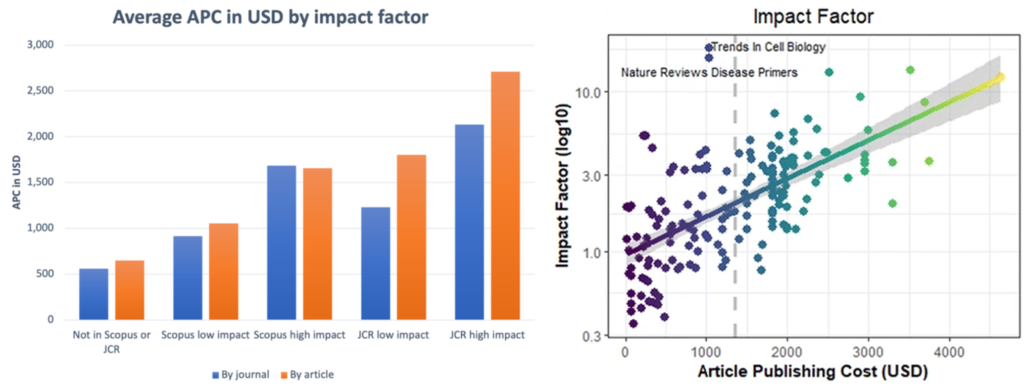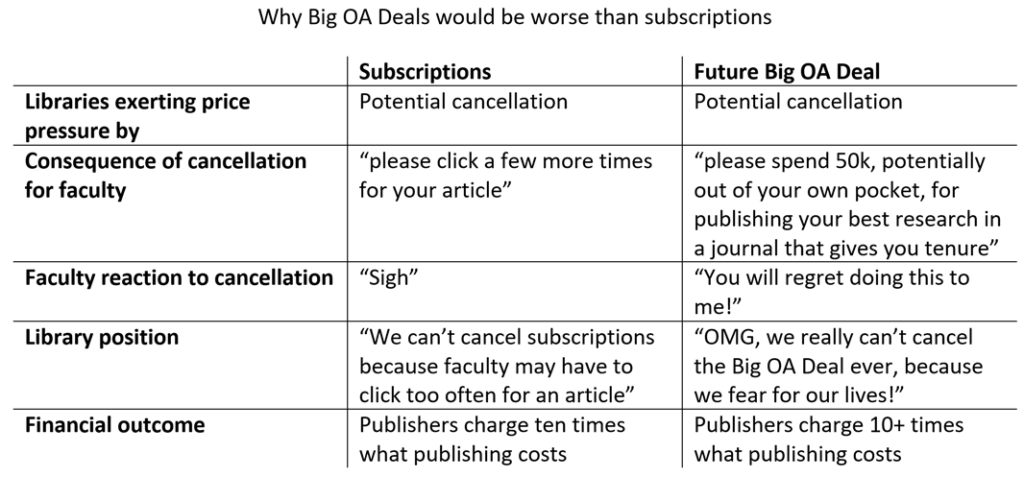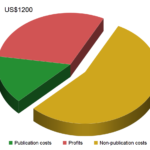Notwithstanding the barrage of criticisms and warnings from every corner of the scholarly community, various initiatives, mainly in the Netherlands, Finland, Germany, France and the UK, continue their efforts for a smooth transition from subscriptions to open access without any further disruptions. The underlying idea is to shift the subscription funds to article processing charges (APCs). While most share the sentiment that subscriptions need to go and the saved funds should be used for publishing, rather than reading, this particular approach has drawn widespread criticism.
The main point of contention is whether this approach is sustainable in the long run. There seem to be unanimous expectations of dropping prices with such a transition. These hopes are mainly based on current estimates of APC prices of around 40% below current subscription costs (calculated as cost-per-article). One may argue that a mere drop of 40% is still a gift to legacy publishers when actual publishing costs are more like 90% below current subscription prices, but this shall not be the main point here.
The main question is: even if publishers eventually agree to a 40% drop in revenue (which seems more likely than not at this point, despite public publisher resistance), how can we keep them from increasing prices to old levels? The initiatives mentioned above are notably silent on how this could be achieved. One hears of rigid price-caps and sincere promises of definitely not paying “outrageous prices”, but so far a clear strategy of what is going to happen if a publisher raises the prices above inflation or even by, say, 40% or 70% has not been made public. I haven’t even heard about a strategy being discussed.
As I see it, there are two main positions these initiatives are taking: for one, there are price caps, above which libraries are not supposed to be paying APCs. The second amounts to simply walking away from any renewal of a contract if the prices become too high. Both cases entail that faculty will have to foot at least some of the bill to publish.
At our institution, we have price caps for our APC-fund and people here simply pay either from their budget or out of their pocket, if the APC is exceeding this cap. Given that APCs scale with journal prestige (Nature Communications being a particularly egregious example with APCs that already exceed average subscription costs per article), it is precisely the most sought-after journals where scholars are most desperate to publish in that will be affected by this policy:

APCs scale with IF, data from two different studies (click for larger picture)
Phrased differently: in the richest institutions, faculty will be able to publish in the most prestigious journals while in the poorer ones, they will have to pay extra for the same glory – or just not be able to publish there at all. In this “APC-capped world”, the rich will stay in science, the poor will have to drop out.
Irrespective of any price caps, with a decades-long publisher track record of double-digit price increases year over year (subscriptions or APCs), every library, then (“serials crisis”) as now, will be faced with budgetary constraints that force them to contemplate dropping the Big Deal for a given publisher. How likely have libraries been to drop subscriptions in such circumstances? Not very, it seems. Despite constant supra-inflation price hikes, libraries have cut other acquisitions, explored additional revenue streams and enlarged their subscription budget over several decades. Faculty demand, it is said, is paramount and hence all publisher demands, no matter how outrageous, have historically been met, until this day, when publisher profits have swelled to 40% and higher. Thus, the fact that faculty need to read has made it virtually impossible for libraries to walk away from subscription negotiations, allowing publishers to essentially charge what they want and getting away with it.
How will this dynamic change once libraries cease to pay for read-access but pay instead for write-access? Without subscription, every article behind a paywall is just a few extra clicks or some wait time further away, than with a subscription. Nevertheless, resistance to subscription cancellations is as high as ever, with some librarians even fearing for their jobs should they cancel subscriptions perceived vital for some of their faculty.
Having lived through several subscription cuts at various institutions, I find this scenario widely unrealistic, but not being a librarian, I have to take such statements at face value. Apparently, if libraries were to cancel read-access through their institutions, forcing faculty to add a few clicks to their reading habits, some of the librarians might risk their jobs. If that is indeed the case, what is a realistic scenario for APC cancellations? What might happen to a librarian if they instead of asking their faculty to spend a few additional clicks for essential articles, blocked their faculty from publishing by not paying APCs anymore? Given the ‘publish or perish’ culture we live in, it is straightforward to assume that should this happen, one very realistic scenario is that of faculty marching on the library with torches, setting fire to the building and tarring and feathering all inside who could not escape.
Obviously, if libraries have extended hyperinflationary subscription Big Deals out of fear of faculty reprisals for decades, they will do so with even more fervor and conviction for Open Access Big Deals, as such cancellations are orders of magnitude worse for their faculty than subscription cancelations.Here is a brief comparison of the subscription scenario, with the Big OA Deal scenario:
Thus, the hopes of transitioning away from subscriptions without some major disruptions are illusionary. In fact, the unintended consequences of such well-meaning efforts will likely be worse than what we have today.















What I don’t understand is that librarian jobs are under serious threat now. My own institution is cutting positions. The publishers want to cut out the librarians and market Big Deals straight to the researchers. Perhaps we need some campaigns to find out how much support there is for hard bargaining as in Germany. I suspect there is much more support among researchers than librarians think.
It is indeed possible that librarians may be misjudging their position wrt publishers and faculty support. I guess one could either try to find that out via surveys or inform them of the support of their faculty.
That is a problem. It may be a smaller problem than now, though.
As a reader you often need one specific article. This is a complete monopoly.
As an author you do not have much choice, but you do have some choice. I could do without Elsevier and still have enough journals left to publish my work.
Nature, your example, would still more or less have a monopoly, but most other publishers would face at least some competition.
Yup, Nature from SpringerNature would be one case, but in my field, Elsevier has Lancet, Cell, and Neuron, which are must-haves for biomedicine/neuroscience. Then you have Wiley with “CA: A Cancer Journal for Clinicians” with an IF four times as high as that of Nature and EMBO Journal. So there you go: already the top three publishers have journals that are without alternative, meaning you can’t drop the publisher’s Big Deal. These three already amount to about 50% of the total subscription revenue today, with an increasing trend. In a Big OA Deal world, these three could essentially charge anything and we would pay.
That would limit the competition between publishers for price. How independent are the journals? May you still have competition between the journals leading to manuscript submission systems that take less than a day to submit a paper?
Indeed, there is the hope that some form of competition would emerge. Alas, these hopes are not based in the publishing reality I’m familiar with. There really isn’t much competition between journals. The reason the IF comes in three digits is to avoid ties. As such, there are essentially no two journals with the same IF. If you can’t get into your top journal, you go to the second and so on. If your ms is accepted, you pay what they ask, because not doing so would mean you have to go even lower – at the considerable risk to you putting food on the table tomorrow.
As I elaborated also elsewhere, there is hardly any (if at all) competition between journals on price: https://bjoern.brembs.net/2016/04/how-gold-open-access-may-make-things-worse/
So any Big OA Deal would essentially lock us even more tightly into a price spiral than the one we’ve been in for the last 20-30 years!
One thing that researchers as authors can do: ask for a discount on APCs, e.g. with reference to the price cap of their university’s open access funds. Worked well for several researchers of “my” [German] university, and we [i.e. the librarians responsible for the funds] continue to encourage our researchers to do so.
Ah, I didn’t know of this possibility. It’s at least worth trying, thanks!